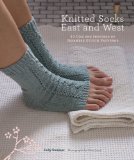Knitted Socks East and West: Â 30 designs inspired by Japanese stitch patterns by Judy Sumner
$22.50, published by STC Craft/Melanie Falick Books (Stewart, Tabori & Chang)
I have a small collection of Japanese stitch pattern books.  They’re fun to flip through:  new stitches, different symbols, unique (to my eye) combinations of cables, lace and twisted stitches.  However, for someone with no background in Japanese knitting, they can also be a bit intimidating.  It’s a lot of work to track down translations of the various symbols and figuring out just how to execute the different stitches.
Knitted Socks East and West is, even for people not obsessed with sock knitting, a good introduction to Japanese stitch patterns.  Sumner has translated the Japanese symbols to those with which we Western knitters are familiar, and introduced and described how to execute a handful of stitches unique to Japanese knitting, such as the PKOK (or peacock, as she calls it).  She’s also thoughtfully paired the patterns and names, and given a brief definition of the word used for the name and her thoughts on the pattern – which makes it a fun book to read as well.
For those of us who are sock-obsessed, Sumner has written 30 patterns consisting of:
•    25 pairs of ‘regular’ socks, from anklets to knee socks
•    1 pair of socks with the big toe separate from the rest of the toes
•    4 other sock variations (for example the pedicure socks).
(A confi dent knitter could pair their regular heel flap, gusset and foot to knit the sock variations like normal socks.)
dent knitter could pair their regular heel flap, gusset and foot to knit the sock variations like normal socks.)
The yarns used vary from fingering to worsted, in a range of price points (Knit Picks & Elann to Schaefer, Lorna’s Laces, and Shibui), and, though mostly wool/merino, in a variety of fibers including cotton, silk and bamboo blends.
The photos for each pattern are both lovely and practical. Â Each pattern has two very clear but nicely staged photos, each showing the sock from a different angle.
Both charts and row by row instructions are given for each pattern.
The stitch patterns include lace, cables, textured patterns, and twisted stitches – often in the same sock pattern.  The level of complexity does vary, however, and a confident beginner should be able to tackle some of the simpler patterns.  Often the pattern is just on the leg, not continued down the top of the foot.
Tsunami, the gray socks shown above, one of the simpler patterns, combines purl diamonds with a simple cable pattern for a very pretty effect.
Because of the size of some of the stitch patterns, Sumner suggests changing yarn &/or needle size to alter sizing rather than adding or deleting pattern repeats. Tatami, which has a woven texture like tatami mats, is given in both adult and child sizes (shown below).
The actual book itsel f is hefty for a paperback, printed on thick matte paper with a crisp, dark font.  The charts have black text against a pastel background.  It’s a tactile pleasure to browse.
f is hefty for a paperback, printed on thick matte paper with a crisp, dark font.  The charts have black text against a pastel background.  It’s a tactile pleasure to browse.
I would definitely recommend this book to sock knitters:  the patterns are very unique, very different from those of other designers.  I would also recommend this to anyone with an interest in Japanese knitting, both for the introduction to the different stitch patterns and for the examples of incorporating the stitch patterns into actual projects. I purchased this book from Amazon; you can do so as well by clicking on the book cover at the beginning of the review.

